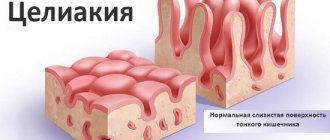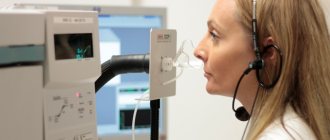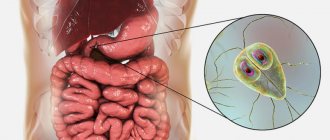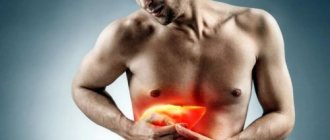- Home /
- Blog /
- Notes of the head physician
April 19, 2021
In recent years, it has been fashionable to focus on a healthy lifestyle. People have become especially interested in what they eat and how eating habits affect their bodies. “Horror stories” have appeared about intolerance to dairy and cereals, which contain lactose and gluten. The opinion has gained popularity that such products should be excluded from the diet.
We have already discussed myths and truths about gluten. This time, the issue of lactose intolerance in adults came under close attention: what are the symptoms of the disease, where does it come from and what tests to take to accurately find out the diagnosis. About all this in our article.
Symptoms of lactose intolerance in adults
If there is not enough lactase in the small intestine, then lactose is sent to the body in broken down form. As a result, within 20-30 minutes after consuming dairy products a person may have:
- bloating,
- diarrhea,
- pain in the intestines,
- nausea,
- rumbling,
- weakness,
- dizziness.
This is how lactose intolerance manifests itself in adults. This disease is also called “lactase deficiency” (LD).
Why is it important to know if you have an intolerance?
When dairy products enter our body, they give us:
- macroelements: calcium, magnesium, potassium, sodium, phosphorus, chlorine, sulfur, phosphates, citrates and chlorides
- trace elements: iron, copper, zinc, manganese, cobalt, iodine, molybdenum, fluorine, aluminum, silicon, selenium, tin, chromium, lead, etc.
- vitamins: almost the entire line of B vitamins, vitamins E, D, H, C, beta-carotene
- proteins, fats and carbohydrates
We are now clear that dairy products are important. They are essential for maintaining bone mineral density. Regular intake of dairy products helps reduce the risk of bone fractures and osteoporosis.
Recent studies claim that consuming dairy products reduces the risks of type 2 diabetes and obesity.
Now let's imagine that after taking milk, you feel unwell, and you decide to completely eliminate it, which means that everything useful that is in milk. But discomfort after eating has happened to everyone, and not necessarily due to lactose intolerance. Therefore, you should not decide without tests that you need to eliminate dairy.
Take a blood test for lactose intolerance with a geneticist's conclusion with a 30% discount
A geneticist will examine the results, tell you whether you have genetic prerequisites for lactose intolerance, and advise you on how to adjust your diet (if necessary).
Why is there not enough lactase in the intestines?
All people have a huge amount of lactase at birth. This is how nature took care of man so that he could survive. Babies feed on their mother's milk and need this enzyme to digest their main food.
There are three types of lactose intolerance in adults.
- Alactasia . Congenital lactase deficiency is extremely rare. This is an inherited autoimmune disease. On Earth, such people can be counted on one hand. Previously, babies with congenital lactase deficiency died, but now, thanks to progress, lactose-free formulas have appeared.
- Secondary hypolactasia. Temporary lactase deficiency occurs after intestinal infections, injuries, and operations on the small intestine. In this case, there is no need to take special actions; you should wait out this period and the enzyme production will normalize.
- Primary hypolactasia. This type of lactase deficiency or lactose intolerance in adults occurs in people who, like everyone else, have a large amount of the enzyme at birth, but it decreases with age. This is genetically determined. Depending on the region of residence, the switching age may be different.
Lactose intolerance in adults is a feature which you can fully live. For more serious diseases, there are special treatment programs at the Mashuk Aqua-Therm sanatorium.
Lactose and lactase: what happens to them in the human body?
If we ignore the true allergy to milk protein (most often cow's), then the vast majority of cases of poor milk tolerance are due to the so-called lactase deficiency. What kind of disease is this? Let's start from the very beginning.
In addition to fats and proteins, the milk of mammals (including humans) contains carbohydrates, primarily the milk sugar lactose. Lactose consists of two molecules of simple sugars - glucose and galactose, connected by a special bond. In order for lactose to be absorbed by humans, this bond must be broken. Only then can the resulting simple sugars glucose and galactose be easily absorbed in the small intestine.
The process of bond cleavage inside the lactose molecule is possible only in the presence of a special enzyme - lactase. The names are similar: the enzyme lactase breaks down the milk sugar lactose. This enzyme is located on the surface of the villi of the small intestine.
In humans and most mammals, the activity of the lactase enzyme is maximum after birth, this allows the absorption of large amounts of milk, which in the first months is the only source of food for the newborn. After stopping breastfeeding, lactase activity gradually fades as a person switches to an adult type of diet, where milk and dairy products are only a small part of the diet.
In some people, the decrease in the activity of this enzyme occurs very quickly, in others it is gradual, and a certain part of people maintain high lactase activity for a long time. What does this depend on?
It is known that the ability of lactase to break down the milk sugar lactose is regulated by a special gene. More precisely, two genes. One gene (LCT) encodes the enzyme lactase; without it, it simply could not be produced. The second gene located nearby is called MCM6, and its task is to regulate the activity of the LCT gene.
For example, it is known that the variant (genotype) of the MCM6 gene, designated C/C, is associated with low activity of the LCT gene, which leads to early lactose intolerance. With the T/T genotype, the activity of the LCT gene is high, even in adulthood. The C/T genotype is the most common variant and is most likely to develop lactose intolerance in middle age.
This information is very important because it is now possible to evaluate the MSM6 gene in laboratories.
So, the activity of the lactase enzyme is regulated by the gene; with age, the likelihood of a decrease in this activity increases. What happens to the milk sugar lactose if there is not enough enzyme to break it down in the small intestine? Some of the lactose will still be broken down and absorbed in the small intestine. The remaining undigested lactose molecules will move further through the small intestine and eventually reach the large intestine. During this process, due to high osmotic activity, lactose attracts water molecules, increasing the amount of fluid in the intestinal lumen, which increases the risk of developing diarrhea. Milk sugar that enters the colon is an excellent nutrient substrate for local bacteria, which actively begin to break it down, producing gases. Increased gas formation and bloating are common symptoms in such patients. In addition, people with impaired breakdown and absorption of lactose may experience mild abdominal pain, nausea and other unpleasant symptoms.
To summarize the above: low activity of the lactase enzyme leads to impaired absorption of lactose in the small intestine. lactase deficiency in medicine . Lactase deficiency, which occurs over time in adults, also has a second name - adult hypolactasia. This article will focus on this most common type of lactase deficiency. We will leave aside congenital lactase deficiency (an extremely rare disease of newborns) and secondary lactase deficiency (occurs as a consequence of a number of gastroenterological, infectious and other diseases).
How to replace products with lactose?
Lactose is found in all dairy products, plus some confectionery products, instant foods, meat, tablets, and dietary supplements. Pay attention to the ingredients.
For people intolerant, lactose-free or plant-based milk is suitable. Or fermented milk products, in which lactose has already been broken down by lactic acid bacteria, so kefir, yogurt, fermented baked milk, as well as butter and cheese do not give an uncomfortable effect.
Lactase enzyme is sold in tablets or capsules. You can drink it before drinking milk. This method should not be used without consulting a doctor.
What is lactose?
Lactose is a carbohydrate. Lactose makes up more than 90 percent of all carbohydrates found in dairy products, which is why it is often called milk sugar. Accordingly, lactose is the main carbohydrate in human milk. It is also present in modern adapted milk formulas.
Why is lactose needed?
- The main source of energy in the baby's body.
- Important for the maturation and normal functioning of the central nervous system, nerves, vision, and joints.
- The substances formed as a result of its breakdown contribute to the formation of beneficial intestinal microflora, the synthesis of vitamins, and the absorption of calcium, magnesium, and manganese. A small amount of undigested lactose normally enters the large intestine, where it contributes to proper intestinal motility and protection from pathogenic and opportunistic microorganisms.
- I would also like to note that the lactose in human milk is different from the lactose in cow's milk. Human milk contains β-lactose, while cow's milk contains predominantly α-lactose. β-lactose, unlike α-lactose, helps the proliferation of beneficial bifidobacteria and the absorption of calcium, magnesium and zinc.
How to determine lactase deficiency?
Whether there is lactase in the body or not is determined by a biopsy of the small intestine, but this route is rarely used. For example, during operations.
Other methods are stool carbohydrate and stool pH tests and the hydrogen breath test. Because hydrogen content increases in adults with lactose intolerance, these quantitative changes can be measured and the presence of deficiency can be determined.
Interesting fact. In China, lactose intolerance in adults is observed in 90% of the population, since they do not drink animal milk at all, but prefer plant milk: soy, almond, etc. This is due to the region of residence and diet: the Chinese love rice, seafood and fish, and from there they get all the necessary substances. Therefore, if you have been diagnosed with lactose intolerance, do not despair and look for an alternative!
What causes lactose intolerance?
The leader in lactose content is mother's milk. Mother Nature is brilliant. She made sure that the mother was able to feed the child. Therefore, almost all of us are born with the ability to digest lactose. So at what point does everything “break”?
When it’s time to switch to a regular diet, the body reduces lactase production. This is how the first type of lactose intolerance is formed.
Primary intolerance
occurs due to a decrease in the amount of lactase with age. This is the most common type of intolerance. It often occurs in a child when breastfeeding ends.
Secondary intolerance
may occur due to gastrointestinal diseases, as a result of intestinal infections or intestinal inflammation.
It became possible to determine whether lactose intolerance exists with the discovery of the MCM6 gene. To understand whether you have lactose intolerance, simply take a lactose intolerance test (with a geneticist’s conclusion) with us at Lab4U with a 30% discount.
Based on the result of the analysis, the geneticist will draw a conclusion on how your body is predisposed to lactose and give practical recommendations on the need to adjust your diet. And, if necessary, he will recommend additional research.
Prevention of lactase deficiency
To prevent this disease, it is necessary to prevent the symptoms of hypolactasia. This is done using a diet with a complete absence of lactose or low content. Therefore, if a patient experiences digestive disorders after eating unfermented dairy products, it is necessary to conduct a genetic test for lactase activity: it will allow you to choose a suitable diet and avoid attempts at pointless treatment. Using this test, you can also predict lactose intolerance in children in order to avoid unexpected intestinal disorders.
Where to take a medical test in St. Petersburg?
"Union Clinic"
St. Petersburg, Nevsky pr., 24 +7 A test for food intolerance as a result of a deficiency of digestive enzymes is carried out: consultation and blood test. How to get there: https://piter.nashigoroda.ru/adresa/1009/
Medical
+7 +7 Anamnesis data, clinical manifestations, stool and blood analysis are studied. How to get there: https://eleosmc.ru/kontakty.html
Medical Center Sokolov A. N.
+7 +7. Anamnesis data, clinical manifestations, and stool analysis are studied. How to get there: https://www.happychild.ru/contact.html
Is it possible to cure and what to do if a baby has lactase deficiency?
If a child is diagnosed with lactase deficiency in the body, parents do not need to worry, because, regardless of the form of the pathology, it can be corrected. But for this it is important not to self-medicate, but to follow the recommendations of the observing pediatrician. Lactase preparations are used to treat children suffering from lactose intolerance. The most effective options are Lactase enzyme, Lactase baby, Lactazar. They are first dissolved in mother's milk and given to the baby.
Important! Lactase drugs do not affect the quality of a woman's milk.
To carry out 1 procedure, 30-50 ml of biological fluid is required. After mixing with the drug, the milk is infused for no more than 3 minutes. First, the newborn needs to be bottle-fed, and only then put to the breast. Lactase preparations are characterized by high therapeutic efficacy. They normalize the state of bowel movements already on the 4th day from the start of their use, intestinal colic is eliminated during the same period or a day later. After 10 days of proper use of the medication, the composition of stool improves.
If the newborn is bottle-fed, with LI he is transferred to low-lactose or lactose-free formulas. Additionally, symptomatic treatment is prescribed - probiotics are recommended, as they normalize the intestinal microflora. The child’s water-salt balance is also corrected. For children suffering from LI, it is necessary to select complementary foods especially carefully - they should not contain lactose.
Actions that will help overcome lactase deficiency:
1. Do not feed according to the schedule. In order for a newborn to consume not only foremilk, but also hindmilk, he needs to empty each mammary gland completely. To do this, you need to give the baby the breast at the initial appearance of his appetite, and not wait for specific feeding hours. Long intervals between feeding a newborn lead to the accumulation of foremilk in the breast, and the likelihood of access to hindmilk is reduced. 2. Do not neglect night feeding of the baby. At this time of day, large amounts of hindmilk are produced. 3. Follow a diet. The specialist will develop a nutrition program for the child regarding complementary foods (it should not be dairy). If the congenital form of LI is confirmed, the baby follows a diet for life. When lactase deficiency is caused by intestinal diseases, the child adheres to a therapeutic diet until the underlying pathology is eliminated. It is important to discontinue the diet gradually, and only after receiving the results of a control stool examination. Lactase deficiency is characterized by a favorable prognosis. A set of measures - the use of medications and maintenance therapy, a proper diet, a well-designed diet for the mother - contributes to the complete elimination of the disease.
Products for people with lactose intolerance
People suffering from this disease need to be careful about what is on the table. Milk sugar is not just milk. It is also found in other foods that are recommended to be excluded from the diet. These include:
- packaged sausages;
- sauces (ketchup, mustard, mayonnaise);
- bakery products;
- packaged soups;
- ice cream;
- nut butter;
- pies, cakes, pastries;
- hamburgers and cheeseburgers;
- condensed milk;
- bulk spices;
- chocolate, lollipops;
- saccharin tablets.
People with lactase deficiency can use:
- soy drinks (including soy milk);
- chicken eggs;
- lard;
- vegetable oil;
- vegetables and fruits;
- grains and legumes;
- nuts;
- honey;
- pasta;
- rye bread without food additives and whey.
Symptoms and signs of lactase deficiency in infants
Symptoms of lactase deficiency in infants can be observed by all attentive parents - the main signs are:
- Newborn behavior. During feeding, he is restless, shows increased activity, tearfulness, and does not respond for a long time to attempts to calm him down.
- Change in the nature of bowel movements. The consistency is liquid, with a sharp, sour odor, and there is a frequent urge to defecate.
- Intestinal peristalsis. During feeding, the baby can hear rumbling in the tummy, which is associated with increased gas formation.
- Intestinal colic. Due to metabolic disorders and disruption of the digestive process, the newborn experiences intra-abdominal discomfort. Intestinal colic begins to bother the child after 30 minutes. after finishing feeding. It is during this period that the process of digestion and breakdown of lactose begins. The child tenses up, cries loudly and for a long time, and actively raises his legs.
- Appearance. A newborn is pale, lethargic, apathetic, and does not correspond to his age.
Indirect signs of LI are the appearance of rashes on the skin of the baby’s face and body. Since the iron content depends on the concentration of lactase in the body, the child may develop anemia, which cannot be eliminated with medications or improving the quality of nutrition.
Other signs of lactase deficiency in infants are a sharp alternation of increased appetite and a period of weakening, tearfulness, and frequent regurgitation. Since nutrition is not beneficial for the growth and development of the body, the child lags behind in physical development and is underweight. Due to the fact that milk is not digested, the baby experiences hunger: a few minutes after putting it to the breast, he loses interest in feeding and cries for a long time.











